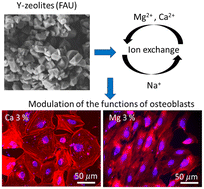Deciphering the role of faujasite-type zeolites as a cation delivery platform to sustain the functions of MC3T3-E1 pre-osteoblastic cells†
Abstract
The control of cell fate assisted by synthetic drug-delivering materials is still a challenging task for spatiotemporal regulation of bioactive molecules in native tissues. In this study, the potential of faujasite type (FAU) zeolites for delivering bioactive ions (i.e. Ca2+ and Mg2+) to pre-osteoblastic MC3T3-E1 cells is unveiled. Zeolites are porous aluminosilicates with a large surface area suitable for the storage of biologically active compounds. However, only a few studies have reported the use of zeolites in tissue engineering; therefore, this study aims to correlate the release profile of zeolites with the resulting cell functions. The textural properties of zeolites were assessed via MEB, BET, XRF, and EDX analyses. This study shows that either Mg-loaded (Mg-Y) or Ca-loaded (Ca-Y) zeolites are able to gradually release ions over up to three weeks in classical culture media in contrast to the burst release profiles often described in the literature. The ion concentration can be adjusted simply through the mass of zeolite added in the system and was quantified by colorimetric methods and capillary electrophoresis. Three zeolite concentrations were tested (i.e. 1, 1.5, and 3 wt%) for both ion types in order to span biologically relevant ranges (from 5.6 to 19.6 mM). The cell responses against various ionic strengths were evaluated not only by the reduction of resazurin assay for viability/proliferation assessment, but also through immunostainings and collagen secretions (Picrosirius red staining). The cell proliferation was found to be proportional to the Ca2+ concentration whereas an upper limit seemed to have been reached for Mg 3% compared to Mg 1% and Mg 1.5%. Matrix secretions were delayed under conditions exposed to Ca2+ relative to Mg2+ after 7 days, but this trend reversed after 21 days. Overall, this study emphasizes the potential role of FAU as a simple, low cost, biocompatible, and versatile way to modulate the functions of MC3T3-E1 cells through ion delivery over up to three weeks. The ion concentration is correlated with the zeolite concentration, and the payload could be easily handled. Thus, this study will make it possible to broaden the applications of zeolites in tissue engineering which can also be implemented in multiple ways including surface coatings and nanocarriers.

- This article is part of the themed collection: Popular Advances


 Please wait while we load your content...
Please wait while we load your content...